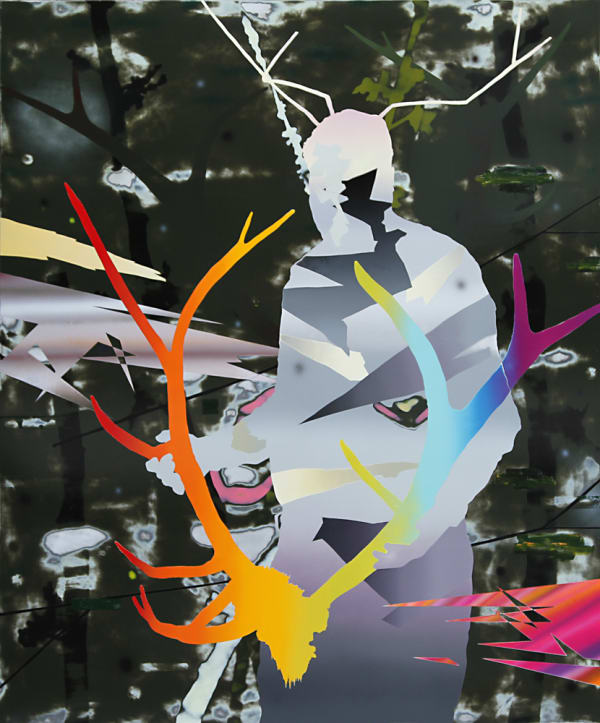the black mirror, back burn, opera
the black mirror, back burn, opera
For the migrant creating a meaningful sense of belonging in a new community can be a fraught and emotionally nuanced journey. Neil Haddon’s work proposes a visual way of evoking this complex process in a series of paintings. To do this Haddon draws on his own experience of migration to Tasmania and presents us with artwork that is a composite interweaving of feelings of belonging, difference, shared versus private history and dislocation felt towards the place of migration.
Haddon often uses imagery derived from local print and television news stories combined with images of everyday activity from his neighbouring surrounds. These images are manipulated to remove the majority of their original content and then used within the paintings, often in conjunction with ambiguous geometric shapes, in a way that confounds their association with the particulars of known places and takes them into new, less habitual territory.
Haddon uses a combination of traditional painting media with less common materials and methods including enamel and polyester paints sprayed onto composite aluminium panels. In the black mirror, back burn, opera he has created an extended environment for the paintings using backdrops, assemblage, carpet, audio soundtracks and a large wall-sized black mirror (a kind of large ‘Claude Mirror’ used extensively in the 17th Century to view ‘picturesque’ landscapes by standing with ones back to the view and looking at it in the mirror). This has the dual function of providing a comforting and yet slightly disorienting context for the work, further complicating the relationship of artwork to the context of its display. This, used in conjunction with the paintings contradictory visual languages, creates an uncertain visual ground, a new territory, that conveys the un-locatable content of the work. In this exhibition Haddon has
Haddon has written of his artwork: “The environment (the conditions in which a particular activity is carried on) of the work exists on two planes: firstly, the place I find myself in defined and delimited by the word ‘Tasmania’ and secondly, the territory of the artwork – it’s ambiguous place. The work that I have made is akin to the artifacts and evidence brought back by an expeditionary team who have been exploring the uncharted territories of the stories and artworks of this environment.
I imagine that in traversing these terrains with my expeditionary team I will form some kind of connection, although, as was the case on earlier colonial expeditions, with the limited resources at my disposal, I must consider what can feasibly be retrieved, brought back and conveyed to an audience, even if only partially. I must also consider the possibility that we will get lost, but that in this moment of disorientation, we will find our escape.
In summary, Haddon’s proposal is to make a group of artworks in a variety of media that are the remnants an exploration of the terrain of endemic narrative, that do not seek to homogenise but rather, acknowledge dissonance and lack of connection and that inhabit their place as the migrant inhabits theirs.
NB.
In light of recent bushfires: the images of fire fighters were derived from a series of photographs that I made up at Mount Nelson where I have my studio and where the local crew were conducting a series of back burns.
-
 Neil HaddonAfter the Burn, 2012high gloss enamel paint and oil paint on aluminium panel170 x 150 cm
Neil HaddonAfter the Burn, 2012high gloss enamel paint and oil paint on aluminium panel170 x 150 cm -
 Neil HaddonBack Burn (after the fire), 2012high gloss enamel paint and oil paint on aluminium panel170 x 160 cmAU$ 12,500.00
Neil HaddonBack Burn (after the fire), 2012high gloss enamel paint and oil paint on aluminium panel170 x 160 cmAU$ 12,500.00 -
 Neil HaddonTrophy Hunter, 2012high gloss enamel paint and oil paint on aluminium panel180 x 150 cmSold
Neil HaddonTrophy Hunter, 2012high gloss enamel paint and oil paint on aluminium panel180 x 150 cmSold -
 Neil HaddonBack Burn (the meeting), 2012high gloss enamel paint and oil paint on aluminium panel150 x 170 cmSold
Neil HaddonBack Burn (the meeting), 2012high gloss enamel paint and oil paint on aluminium panel150 x 170 cmSold -
 Neil HaddonRunning Scared (the second time), 2012high gloss enamel paint and oil paint on aluminium panel150 x 120 cmSold
Neil HaddonRunning Scared (the second time), 2012high gloss enamel paint and oil paint on aluminium panel150 x 120 cmSold -
 Neil HaddonGrounded, 2012high gloss enamel paint and oil paint on aluminium panel120 x 110 cmSold
Neil HaddonGrounded, 2012high gloss enamel paint and oil paint on aluminium panel120 x 110 cmSold -
 Neil HaddonLosing it (pink and blue), 2012high gloss enamel paint and oil paint on aluminium panel80 x 70 cmSold
Neil HaddonLosing it (pink and blue), 2012high gloss enamel paint and oil paint on aluminium panel80 x 70 cmSold -
 Neil HaddonLosing it (the slow walk), 2012high gloss enamel paint and oil paint on aluminium panel60 cx 54 cmSold
Neil HaddonLosing it (the slow walk), 2012high gloss enamel paint and oil paint on aluminium panel60 cx 54 cmSold









